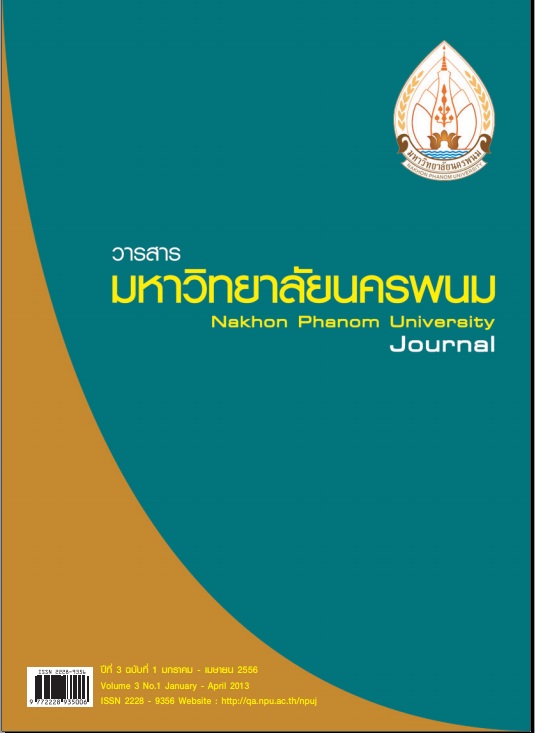ปัจจัยที่ส่งผลต่อการตัดสินใจแก้ไขสถานการณ์ในชีวิตประจำวัน เรื่องสารชีวโมเลกุลของนักเรียนชั้นมัธยมศึกษาปีที่ 6 ที่ได้รับการจัดกิจกรรมการเรียนรู้ตามแนวคิด วิทยาศาสตร์ เทคโนโลยี และสังคม (STS)
Main Article Content
Abstract
การวิจัยครั้งนี้มีวัตถุประสงค์เพื่อ ศึกษาปัญหาการเลือกบริโภคอาหาร ภาวะโภชนาการ และการดำเนินชีวิตของนักเรียนและชุมชนใกล้เคียงโรงเรียนเชียงยืนพิทยาคม จังหวัดมหาสารคาม ที่พบว่าไม่ได้อาศัยพื้นฐานความรู้ทางวิทยาศาสตร์ ขาดความเข้าใจระหว่างความสัมพันธ์ของวิทยาศาสตร์ที่มีต่อสังคมและเทคโนโลยี จึงนำไปสู่วัตถุประสงค์การวิจัยคือ 1) เพื่อศึกษาปัจจัยที่ส่งผลต่อการตัดสินใจแก้ไขสถานการณ์ในชีวิตประจำวัน เรื่อง สารชีวโมเลกุลของนักเรียนชั้นมัธยมศึกษา ปีที่ 6 ที่ได้รับการจัดกิจกรรมการเรียนรู้ตามแนวคิดวิทยาศาสตร์ เทคโนโลยี และสังคม และ 2) เพื่อศึกษาข้อดีและข้อจำกัดของการจัดการเรียนรู้ตามแนวคิดดังกล่าวซึ่งในการวิจัยครั้งนี้เป็นการวิจัยเชิงคุณภาพที่ยึดถือกระบวนทัศน์เชิงตีความ (Interpretative Paradigm) โดยใช้วิธีการกำหนดสถานการณ์ในชีวิตประจำวันเรื่องสารชีวโมเลกุล ทั้ง 4 ชนิด ได้แก่ โปรตีน คาร์โบไฮเดรต ลิพิด และกรดนิวคลิอิก อย่างละสถานการณ์ แล้วให้นักเรียนในแต่ละกลุ่มได้ศึกษาสถานการณ์พร้อมทั้งหาวิธีการแก้ไขสถานการณ์ที่กำหนดโดยอาศัยแผนการจัดการการเรียนรู้ตามแนวคิดวิทยาศาสตร์ เทคโนโลยี และสังคม จนกระทั่งนักเรียนสามารถอภิปรายและสังเคราะห์ข้อมูล วิธีการ แล้วนำไปสู่การตัดสินใจเลือกวิธีการและดำเนินการแก้ไขสถานการณ์ที่กำหนดให้ และสรุปเป็นปัจจัยที่ส่งผลต่อการตัดสินใจในการแก้ไขสถานการณ์ที่กำหนดให้โดยอาศัยการวิเคราะห์บทสนทนาของนักเรียน ใบงาน แบบสังเกตพฤติกรรม แบบสัมภาษณ์และการบันทึกอนุทินของนักเรียน จากผลการศึกษาพบว่าปัจจัยที่ส่งผลต่อการตัดสินใจสามารถแบ่งออกได้เป็นสองส่วนคือ 1) ปัจจัยภายใน และ 2) ปัจจัยภายนอก ซึ่งปัจจัยภายใน ประกอบด้วย 1) ความรู้เดิมของนักเรียน กล่าวคือ นักเรียนอาศัยความรู้เดิม และความรู้ที่ได้จากการศึกษา มาเป็นตัวแปรหนึ่งประกอบการตัดสินใจ 2) ประสบการณ์ของนักเรียน กล่าวคือ นักเรียนมีแนวความคิดแตกต่างกันไป ประสบการณ์ของนักเรียน ไม่ว่าจะเป็นการเผยแพร่ข้อมูล การนำเสนอข้อมูล หรือแม้กระทั่งการอาศัยความร่วมมือจากหน่วยงานอื่น 3) ความคิดเห็นส่วนบุคคลหรือความรู้สึกนึกคิดเกี่ยวกับตน กล่าวคือ ในการตัดสินใจของนักเรียนนั้น นักเรียนนำความคิดเห็นส่วนตัวมาเป็นส่วนหนึ่งประกอบการตัดสินใจและนำเสนอความคิดเห็นของตนเองต่อเพื่อนสมาชิกในกลุ่ม เพื่อให้เกิดการยอมรับและมีการนำความเห็นนั้นมาเป็นส่วนประกอบของการแก้ปัญหาในสถานการณ์ที่ถูกกำหนดมาให้ และ 4) ความตระหนักถึงสภาพแนวคิดของสังคมและท้องถิ่นของตนรวมไปถึงพฤติกรรมของมนุษย์ต่อสังคม เช่น การพยายามให้ความรู้และการปรับเปลี่ยนพฤติกรรมในบริโภค ปัจจัยภายนอก เป็นปัจจัยที่อยู่นอกเหนือการควบคุมของตัวบุคคลในขณะที่มีการตัดสินใจ ประกอบด้วย 1) ปัจจัยทางด้านเศรษฐกิจ ซึ่งเป็นปัจจัยที่ชี้ให้เห็นถึงวิธีการจัดสรรการใช้ทรัพยากรภายใต้สภาพแวดล้อมทางด้านเศรษฐกิจ 2) ปัจจัยทางด้านสังคม ซึ่งเป็นการอธิบายถึงโครงสร้างทางสังคมที่บุคคลไปเกี่ยวข้อง 3) ปัจจัยทางด้านการเมือง เช่น ลักษณะการปกครอง ความมั่นคงของชุมชน ความเชื่อถือในตัวผู้นำชุมชน และปัจจัยทางด้านเทคโนโลยี เช่น การนำเทคโนโลยีมาใช้ และข้อดีจากการจัดกิจกรรมการเรียนรู้ตามแนวคิดวิทยาศาสตร์เทคโนโลยีและสังคมพบว่าสามารถส่งเสริมความตระหนักถึงความสัมพันธ์ระหว่างวิทยาศาสตร์ เทคโนโลยีและสังคม สามารถประยุกต์ใช้ความรู้ในสถานการณ์ใหม่ได้รวมถึงมีเจตคติที่ดีต่อการเรียนรู้วิทยาศาสตร์ ส่วนข้อจำกัดที่เป็นข้อค้นพบจากการวิจัยคือ หากไม่ได้รับความร่วมมือจากผู้เรียนหรือผู้เรียนไม่แสดงออกถึงความคิดเห็น จะทำให้กิจกรรมการเรียนรู้ตามแนวคิดนี้ไม่สามารถดำเนินการให้ประสบผลสำเร็จได้
The objective of this research were to : 1) Examine affecting factors the daily life situations solutions with Bimolecular based on Science, Technology and Society Approach in Matthayomsuksa 6 students and 2) Study the advantages and limitations of the learning concept of the Science, Technology and Society Approach. This research was qualitative research that extents the in terpretative paradigm by means of daily life situations work
on 4 types of bimolecular including proteins, carbohydrates, lipids and nucleic acids. Students in each group were studied the situations and found out solution to given situations based on learning plan of science, technology and society until students were able to discussed and synthesized information to solve the problems. They decided how to implement a given situations and summarized the factors were affecting the decision to resolve the situations based on analysis of student conversation and observation sheet, diaries of student record and interviews. The result was showed that, there were two parts of affect factors 1) Internal factors and 2) External factors as follows : Internal factors included 1) Students’ background knowledge, the students able to gather
between background knowledge and new knowledge they have gained as a variable to their decision, 2) students’ experiences were different ideas. Therefore, students’ experienced by themselves, information was expanded, presented or even cooperated with other agencies, 3) The personal thinking or opinions, students were introduced a part of their decision and presented the opinions to their group. The solution was solved followed the approved the opinions by group members, and 4) Society and local wisdom awareness, therefore human behavior in the society as attempted to educate and change consumer behavior. External factors beyond the control of the individual to making decisions were 1) Economic factors, which arrange of resources in order to economic environment, 2) Social factors, which describes the social structure that involved, 3) Political factors such as a rule, security community, trust in the community leader and 4) Technological factors such as technology in used. The advantage of the learning activities based on science, technology and society approach were: students able to promotes awareness of the relationship of science, technology and society, applied knowledge for new situations, and good attitude towards learning science. There limitation of the research in learning activities based on science, technology and society approach was the research cannot continue until successful without students’ cooperation and students’ express opinions.


